|
| ||
|
Blueberries |
Fencing ~ Tools ~ Helpers
Wild or Tame, keeping Animals in and out of the Fruit Trees and Berries. and Tools for the healthy Backyard Orchard and Homestead Food Forest
Four decades of Growing
Good Food
in the Northwoods of Michigan's Upper Peninsula |
|
|
April 7, 2021 --
House Cleaning Time I had on my list of things to do to clean out the birdhouses but hadn't gotten to it. This early spring weather (and a lot of hiking days!) has scattered my schedule . But today when I walked into the orchard I heard a new bird voice, familiar and happily welcome - the bluebirds were back! I didn't see them but I immediately changed my plan, got ladder and tools and went to work cleaning out the birdhouses. We have eight on the fence around the acre orchard/garden, four along the south and center are the domain of the bluebirds and barn swallows, each with their favorites, and the other four varies as to occupants. As I pulled out old nesting materials of the first four I was happy to find apparently successful nests, used and empty, or made but not used. The bluebirds and swallows had a good year, and we sure appreciate the work they do. Our houses are of two designs, the older ones I have to take off the tops, hence the ladder. The newer ones are of better design and one screw allows a side board to be opened from the bottom, hinged at the top. When I got to the 5th box, on the far east fence near a white pine woods, I pulled up the side board (no need to climb the ladder for these) to find a nice pile of grass. Obviously this box had been filled but not used. I put my garden fork in to pull the pile out and instead out jumped a surprised mouse, onto a VERY surprised woman. Down she went (the mouse, not me) and immediately ran back up the fence post and into her nest. I wish I could have taken a photo of her because she was a beautiful beige white footed mouse. Well. I debated, very likely babies were aboard but I didn't really want to house a mouse. So I went and got a bucket and lid, carefully scooped mouse and nest in and moved all to what I thought might be a nice place under a large low on-the-ground fir branch. She, of course, scurried off but hopefully returned to repair and re-establish her nest somewhere else to her liking. The other three boxes were uneventful. The one by the north fence gate was full of twigs as it often is, the domain of a local wren. The last box is one of the newer ones, down at the northwest corner, not used its first year two years ago. There is more traffic here and near to the woods and more shady so not likely to be as popular. But I had noticed chickadee activity last year and sure enough they had built, and used, a cozy nest full of moss and feathers in this box. Mostly the chickadees nest in the plentiful woods so it will be interesting to see if anyone uses this box this year. My job done I headed out the gate and as I did I saw the male bluebird, landing briefly on that last nest box before flying back into the woods. I like to think he came out to say Hi and thanks for the house cleaning job.
We sorted through the old insulators for those still in good shape, bought
new ones. Went back to get the RIGHT new ones. Went back again for yet
another bag. Screwed insulators to wooden posts, finagled
There is still a lot of work to be done on the new fence (and removing old fence posts) but the new area is now enclosed, and it feels good! We've been working on it over several weeks but the big day was when we had to take down old fence and re-install it in the new form. Once we started it had to get done that day to keep the old garden/orchard secure from interested deer. These things seem to always take longer than one thinks, but it was done before dark. And we're satisfied with that.
At the north end I had to move an old brush pile that was in the line and
discovered a gold mine (if one is a grower of plants and trees) of well
rotted stuff at the bottom. Well worth the work! At the south end I found
(unfortunately with the lawn mower!) a nice rock, maybe 10” sticking above a
raised area. Since we’re collecting rocks for our someday pond this was a
good find. It was mostly buried, and I had to flatten that area anyway, so I
got the shovel to dig it out. Surprise! Turns out it is maybe 3 feet across,
and who knows how deep -- I didn’t go that far! So I dug out around it and
we have a nice “point of interest” along that part of the fence. Thankfully
the chosen fenceline runs just north of it. The large rock is a companion to
our old “snake rock” about 100 ft away. This one is mostly above ground
(actually, we don’t know how much is below ground). In our early years here
we saw a garter snake sunning itself on this large rock and henceforth it
has been Snake Rock. Every project needs a friendly supervisor. Our resident rodent harasser LilliB enjoyed surveying the job I was doing for a short time. But she soon turned her attention to more interesting endeavors.
Whether you're growing a small patch of grain, cutting some hay, or just wanting to keep an area mowed without a gasoline engine flapping in your ear, the scythe is a great tool. We managed to get a good one many years ago, and I recommend it enthusiastically it if you can find one similar. We first had one of those heavy, hardware store models -- which was a joke, though not a
very funny one if you were trying to do any serious work with it. Then we splurged for a
model purchased from Smith and Hawken (this was way back when they sold quality tools, no
relation to the current catalog by the company of the same name). Our scythe was made by
Hand & Foot Ltd, Green River Rd, PO Box 611, Brattleboro, Vermont 05301. After almost
twenty years, it is still in great shape, though much broken in. I mostly use an electric
battery powered mower now, one that can be charged up from our solar
electric system. It isn't any faster but it's more pleasant than the gasoline
and is my first choice. These mowers have come a long way since our first
ones. They are much more practical. However, when growth gets tall it's more
than the electric can handle so the old gasoline mower, which has been asked to
mow things more than the manufacturer planned I'm sure, comes to the rescue. I
use whatever tool makes the most sense to me, and what I enjoy the most. * * * * * * P.S. - For many years after Smith and Hawken changed their direction and dropped those great tools they used to carry we couldn't find a source for these excellent scythes. But this was before the internet opened up the world for those of us in rural areas. It seems that almost anything you want is available somewhere now! Go for a good one, it's well worth it. Copyright © Susan Robishaw |
||
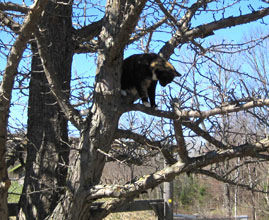
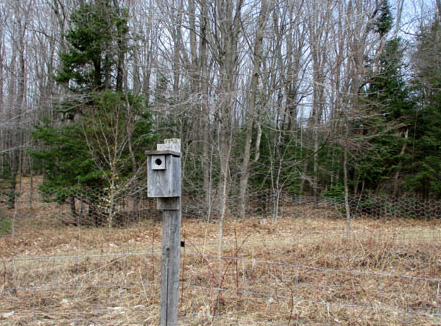
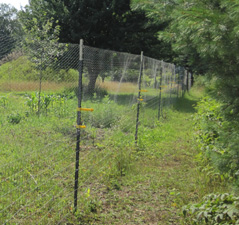 We
had finished a significant part of the new fence -- posts and fencing -- the end
of May, securing the garden and orchard from deer intrusions and anything else
that might wander by but not be of the climbing sort. Off and on over the next
months we worked on other odds and ends of finish work, removing the old fence
posts, filling in the holes, tying poultry wire to field fence, eliminating
gaps, finishing the gates. But we hadn't yet done the big, important last part
-- the electric wire. From long and painful experience we knew that without it
there was little chance of us harvesting our corn, or cherries (when we once
again have cherries), and maybe other fruit. Thankfully the raccoons hadn't
shown up to go after the strawberries or blueberries or raspberries. They must
have been busy elsewhere. But the corn was ripening, so we went to work.
We
had finished a significant part of the new fence -- posts and fencing -- the end
of May, securing the garden and orchard from deer intrusions and anything else
that might wander by but not be of the climbing sort. Off and on over the next
months we worked on other odds and ends of finish work, removing the old fence
posts, filling in the holes, tying poultry wire to field fence, eliminating
gaps, finishing the gates. But we hadn't yet done the big, important last part
-- the electric wire. From long and painful experience we knew that without it
there was little chance of us harvesting our corn, or cherries (when we once
again have cherries), and maybe other fruit. Thankfully the raccoons hadn't
shown up to go after the strawberries or blueberries or raspberries. They must
have been busy elsewhere. But the corn was ripening, so we went to work.
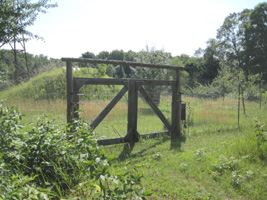 appropriate ones
through the poultry fencing onto the metal posts, untangled and strung out
miles (it seemed) of electric fence wire, went around again and again and
again making sure the electric wires weren't touching the poultry fencing
which had a tendency to bulge out at the wrong places, tying it back
to the sturdier field fence or a stake where necessary. Around and around
the fence pulling tall grass and weeds out away from the wires. Figuring out
how to electrify the gates without electrifying us whenever we went in or
out. Turn on the fencer, find out why it wasn't working, what was shorting
out where. Pound in extra rebar 'staples' to make sure the fence was well
grounded, and make sure there were no gaps for someone to slip under. A few
days of intense long hours but in the end - hurray, five bright lights on
the fencer tester! We slept well last night, and are looking forward to the
first ripe corn soon.
appropriate ones
through the poultry fencing onto the metal posts, untangled and strung out
miles (it seemed) of electric fence wire, went around again and again and
again making sure the electric wires weren't touching the poultry fencing
which had a tendency to bulge out at the wrong places, tying it back
to the sturdier field fence or a stake where necessary. Around and around
the fence pulling tall grass and weeds out away from the wires. Figuring out
how to electrify the gates without electrifying us whenever we went in or
out. Turn on the fencer, find out why it wasn't working, what was shorting
out where. Pound in extra rebar 'staples' to make sure the fence was well
grounded, and make sure there were no gaps for someone to slip under. A few
days of intense long hours but in the end - hurray, five bright lights on
the fencer tester! We slept well last night, and are looking forward to the
first ripe corn soon. ORCHARD - New Garden/Orchard Area Enclosed! - May 15, 2017
ORCHARD - New Garden/Orchard Area Enclosed! - May 15, 2017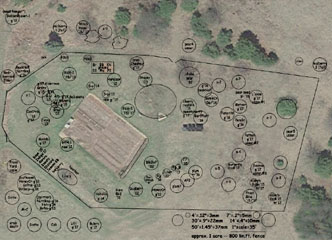
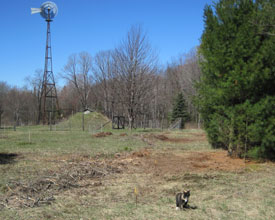
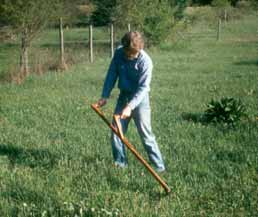 The
Scythe and the
Power Mower
The
Scythe and the
Power Mower